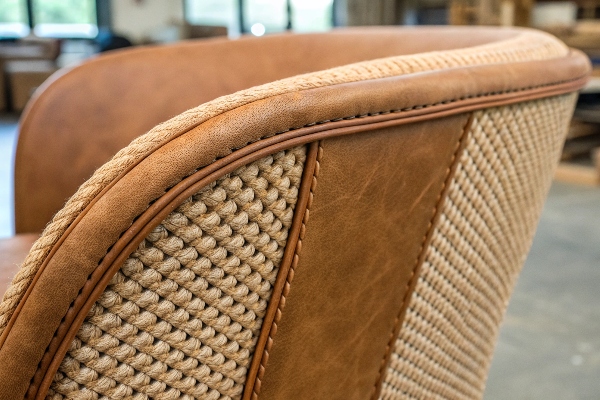Feeling unsure when you shop for a leather sofa? I understand the worry—nobody wants to pay premium prices for plastic.
A real-leather sofa shows uneven grain, warm touch, and natural scent, while faux leather feels cold, smells like chemicals, and has perfect repeating patterns. A quick look, pinch, and smell reveal the truth.

I once bought a “bargain” couch that peeled in months. Since then, I follow a simple check-list before any purchase. Let me walk you through it so you avoid my mistake and pick a sofa that lasts and looks great.
How to tell if a couch is real or fake leather?
You press on the armrest. The surface looks flawless, almost too flawless. Your gut says something is off.
Gently press and release. Real leather wrinkles and shows slight color shift, while faux keeps its shape. The natural hide has elastic fibers that react to pressure; synthetics do not.

Dive deeper: why does leather wrinkle while vinyl stays stiff?
Fiber structure
Real leather is made from interwoven collagen. These fibers stretch and compress like a net.
| Material | Core fibers | Reaction to pressure |
|---|---|---|
| Full-grain leather | Collagen | Wrinkles, darkens |
| Bonded leather | Mixed leather dust + PU | Minor wrinkles |
| PVC/PU faux | Plastic matrix | No change |
Elastic memory
When I press my own leather sample from the factory floor, it springs back yet leaves a soft fold. That fold shows life. Plastic lacks this memory. If the sofa stays flat after your thumb test, you are likely looking at faux.
How can you tell faux leather from real leather?
You flip a cushion and notice an edge seam. The cut surface looks smooth like plastic, not fibrous.
Check the backside. Real hide shows suede-like fuzz; faux reveals a woven or knit fabric backing that has been laminated with plastic. The backing tells the story.

Dive deeper: reading the layers from the inside out
Layer breakdown table
| Layer | Real leather | Faux leather |
|---|---|---|
| Top | Natural grain, scars, pores | Embossed pattern |
| Mid | Fibrous, uneven | Solid PU/PVC |
| Back | Sueded flesh side | Textile knit or felt |
Practical tip
When I visit suppliers for WanDao, I ask to see loose cuts. I rub the back between my fingers. Real hide sheds tiny fibers and feels warm. Faux feels cool and slick. Vendors know I will walk away if they refuse the backside test.
How to tell the difference between a leather and vinyl couch?
You smell the seat. A rich, earthy aroma rises—or maybe there is a sharp plastic note.
Real leather has a distinct smell of oils and tannins that no lab can fully fake. Vinyl couches smell like new car plasticizers and sometimes off-gas for weeks.

Dive deeper: scent science for shoppers
Natural aroma
Leather’s smell comes from plant or chrome tannins binding to collagen. These molecules release slowly. I can still detect the scent on a sofa after five years.
Synthetic odor
Vinyl emits volatile organic compounds (VOCs). Common ones are phthalates. They smell synthetic, sometimes sweet. Your nose can learn the difference.
| Test | Leather | Vinyl |
|---|---|---|
| First sniff | Earthy, woody | Sweet, chemical |
| After weeks | Mild, pleasant | Fades or still plasticky |
| Health impact | Low VOC | Possible irritants |
When I guide clients, I ask them to close their eyes and inhale. Nine times out of ten, they pick the real hide based on scent alone.
How to tell if fabric is real leather?
You run your palm over the surface. It feels warm, then cools slowly. Faux stays at room temperature.
Temperature and texture give clues. Real leather warms with touch, shows pores, and varies in grain. Fabric or coated PU stays uniform.

Dive deeper: the heat and pore test
Thermal conductivity
Leather is a natural insulator. It draws heat from your hand, then warms up. Plastic has lower thermal response. Hold your palm for ten seconds; note the change.
Pore visibility
Use a small flashlight.
| Observation | Real leather | Faux |
|---|---|---|
| Pores | Irregular sizes, uneven | Perfect repeats |
| Grain | Scars, bug bites acceptable | Uniform print |
I once demonstrated this to a buyer in Dubai. We compared two car seat covers. After the warm-up test, he laughed and switched to my eco-PU option because he felt the difference instantly.
Conclusion
Press, peek, sniff, and touch—four simple tests that help you spot real leather and avoid costly mistakes.
